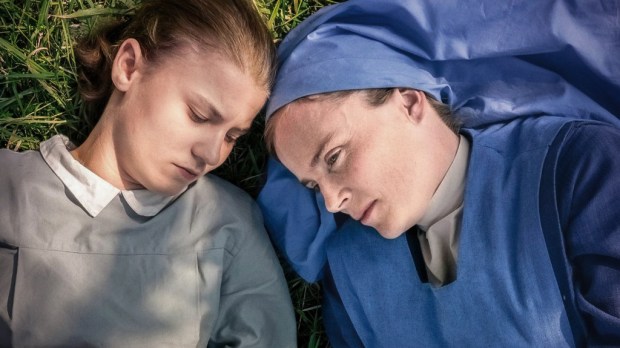Like Helen Keller, Marie Heurtin of Vertou, France, was “locked in a world of darkness and silence.” Both women were born in the 1880s, and both had “miracle worker” teachers who used sign language via their hands to teach them to communicate. But while Keller lost her sight and her hearing at 19 months old, Heurtin was blind and deaf from birth.
The opening frames of the Bresson-esque Marie’s Story (streaming now on Netflix) bring us into 14-year-old Marie’s world: her hands caressing the sunlight, her chest and neck secured with rope, a cautious smile on her face. She’s with that “other” that she trusts, a face whose contours she knows well. But Marie’s helpless father is taking her to more capable hands: the Daughters of Wisdom, a local order of nuns who run a school for the deaf.
The sister tasked with getting Marie down from a tree (needless to say, Marie doesn’t appreciate the sudden turn of events) is captivated by this feral creature. “Today I met a soul,” Sister Marguerite writes in her diary. “A tiny little soul, quite fragile. An imprisoned soul that I saw shine brightly through her prison bars. … How can we talk to her? Listen to her? What is it like to live in total darkness and silence?”
Marguerite has a revelation: to understand and communicate with Marie — “to give her speech so she may enter the world” — is her calling. But the way of costly grace can be tedious and thankless. Her “tutoring” sessions are really nothing more than wrestling and screaming matches punctuated by recalcitrant silence. As the other sisters and pupils glare at them, we can feel her impatience and shame welling up.
But Marguerite doesn’t give up on her student — or herself. Cradling Marie’s prized possession, a small pocket knife given to her by her parents, Marguerite makes a cutting motion on Marie’s forefingers, the sign for “knife.” She does it again, and again, and over again. When Marie begins to make the sign on her own and connect it with the object, Marguerite is ecstatic: the “daughter of her soul” has been born.
This scene mirrors that famous passage of Hellen Keller’s, where she describes her entrance into a world of signs with her Virgil, Anne Sullivan:
We walked down the path to the well-house, attracted by the fragrance of the honeysuckle with which it was covered. Someone was drawing water, and my teacher placed my hand under the spout. As the cool stream gushed over one hand she spelled into the other the word water, first slowly, then rapidly. I stood still, my whole attention fixed upon the motions of her fingers. Suddenly I felt a misty consciousness as of something forgotten — a thrill of returning thought; and somehow the mystery of language was revealed to me. I knew then that “w-a-t-e-r” meant the wonderful cool something that was flowing over my hand. That living word awakened my soul, gave it light, hope, joy, set it free! There were barriers still, it is true, but barriers that could in time be swept away. I left the well-house eager to learn. Everything had a name, and each name gave birth to a new thought. As we returned to the house every object I touched seemed to quiver with life. That was because I saw everything with the strange, new sight that had come to me.
Keller goes on to describe learning more abstract words like “mother” and “father,” as well as a flowering of new emotions: repentance, sorrow, joy.
The same is true of Marie. Like a toddler, she becomes eager to know about everything, from the simple objects surrounding her to the highest philosophical problems of God and mortality. Like Keller, her deliverance into the world is social, and that social bond opens up new vistas — not just of the intellect but of the spirit.
To watch Marie’s long road to this breakthrough, and her rapid transformation afterward, is awe-inspiring. It’s also, at bottom, a very universal story. Novelist Walker Percy was convinced that Keller’s breakthrough with “w-a-t-e-r” revealed “the Delta phenomenon” — an irreducible, triangular relationship between the signifier, the signified and the sign — which gets at the heart of human life. “Before, Helen had behaved like a good responding organism,” Percy observed in The Message in the Bottle. “Afterward, she acted like a rejoicing symbol-mongering human.” In a word, she became Anne’s co-celebrant — of water, sorrow and everything else under the sun.
Marie’s story has the same effect: in conveying what it means to speak of the world, it conveys what it means to be in the world.
Matthew Becklo is a husband and father, amateur philosopher and cultural commentator at AleteiaandWord on Fire. His writing has been featured in First Things, The Dish and Real Clear Religion.

